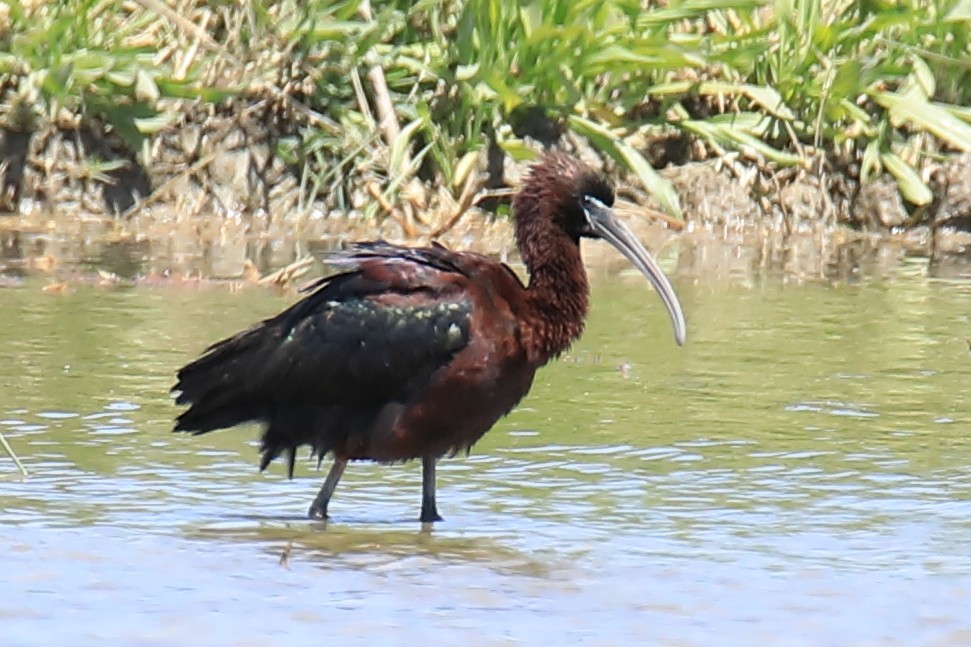Glossy Ibis
A species of Plegadis Ibises Scientific name : Plegadis falcinellus Genus : Plegadis Ibises
Glossy Ibis, A species of Plegadis Ibises
Botanical name: Plegadis falcinellus
Genus: Plegadis Ibises
Content
Description People often ask General Info
Description
This species is a mid-sized ibis. It is 48–66 cm (19–26 in) long, averaging around 59.4 cm (23.4 in) with an 80–105 cm (31–41 in) wingspan. The culmen measures 9.7 to 14.4 cm (3.8 to 5.7 in) in length, each wing measures 24.8–30.6 cm (9.8–12.0 in), the tail is 9–11.2 cm (3.5–4.4 in) and the tarsus measures 6.8–11.3 cm (2.7–4.4 in). The body mass of this ibis can range from 485 to 970 g (1.069 to 2.138 lb). Breeding adults have reddish-brown bodies and shiny bottle-green wings. Non-breeders and juveniles have duller bodies. This species has a brownish bill, dark facial skin bordered above and below in blue-gray (non-breeding) to cobalt blue (breeding), and red-brown legs. Unlike herons, ibises fly with necks outstretched, their flight being graceful and often in V formation. It also has shiny feathers. Sounds made by this rather quiet ibis include a variety of croaks and grunts, including a hoarse grrrr made when breeding. 
Size
58 cm (23 in)
Colors
Brown
Black
Green
Red
Life Expectancy
20 years
Nest Placement
Ground
Clutch Size
3 - 4 eggs
Incubation Period
1 brood
Number of Broods
20 - 22 days
Nestling Period
8 - 9 days
Feeding Habits
Glossy Ibis's diet is seasonal and varied, feeding on insects, crustaceans, mollusks, amphibians, and sometimes small vertebrates. Foraging by probing in mud or water or picking on dry land, glossy Ibis adapts techniques based on the environment and preys largely on availability.
Habitat
Glossy Ibis favor diverse wetland habitats, predominantly freshwater or brackish locales with emergent vegetation like reeds. Adaptable, they inhabit marshes, swamps, flood-plains, lagoons, and man-made waters like reservoirs. While generally eschewing coasts, they may occasionally forage in estuaries or salt marshes and roost in large trees, often far from feeding areas.
Nest Behavior
Both glossy Ibis parents collaborate in nest building, with the male gathering most materials. They continuously add to the nest, including green vegetation, during the egg-laying phase. Parental care extends to both eggs and hatchlings.
Nest Characteristics
Glossy Ibis typically constructs large, bulky nests near wetlands, composed of reeds, sticks, or whatever vegetation is available. These platforms are often positioned in bushes or trees, up to 12 feet high, averaging around a foot in diameter and varying in thickness.
Dite type
Aquatic invertebrate eater
People often ask
General Info
Feeding Habits
Bird food type
Sounds
Call
Recording location: Ethiopia
Call
Recording location: India
Behavior
Glossy Ibis exhibit social tendencies throughout their lifecycle, engaging in collective feeding, roosting, and breeding in cohesive flocks and dense colonies. They exhibit territorial behavior when defending their nesting space from intruders. Typical courtship includes bows, mutual preening, bill-clattering, and cooing near their nests. In flight, glossy Ibis form coordinated flocks, often mistaken for cormorants, although they incorporate more gliding. They usually forage in shallow waters, but can adapt to deeper waters and even swim if necessary. Sunbathing with wings spread is a distinctive behavior for thermoregulation.
Distribution Area
This is the most widespread ibis species, breeding in scattered sites in warm regions of Europe, Asia, Africa, Australia, and the Atlantic and Caribbean regions of the Americas. It is thought to have originated in the Old World and spread naturally from Africa to northern South America in the 19th century, from where it spread to North America. The glossy ibis was first found in the New World in 1817 (New Jersey). Audubon saw the species just once in Florida in 1832. It expanded its range substantially northwards in the 1940s and to the west in the 1980s. This species is migratory; most European birds winter in Africa, and in North America birds from north of the Carolinas winter farther south. Though generally suspected to be a migratory species in India, the glossy ibis is resident in western India. Birds from other populations may disperse widely outside the breeding season. While generally declining in Europe, it has recently established a breeding colony in southern Spain, and there appears to be a growing trend for the Spanish birds to winter in Britain and Ireland, with at least 22 sightings in 2010. In 2014, a pair attempted to breed in Lincolnshire, the first such attempt in Britain A few birds now spend most summers in Ireland, but as yet there is no evidence of breeding there. In New Zealand, a few birds arrive there annually, mostly in the month of July; recently a pair bred amongst a colony of Royal Spoonbill. 
Species Status
The glossy ibis is one of the species to which the Agreement on the Conservation of African-Eurasian Migratory Waterbirds (AEWA) applies. Glossy ibises can be threatened by wetland habitat degradation and loss through drainage, increased salinity, groundwater extraction and invasion by exotic plants. The common name black curlew may be a reference to the glossy ibis and this name appears in Anglo-Saxon literature. Yalden and Albarella do not mention this species as occurring in medieval England. 
Scientific Classification
Phylum
Chordates Class
Birds Order
Pelicans and Relatives Family
Ibises and spoonbills Genus
Plegadis Ibises Species
Glossy Ibis 